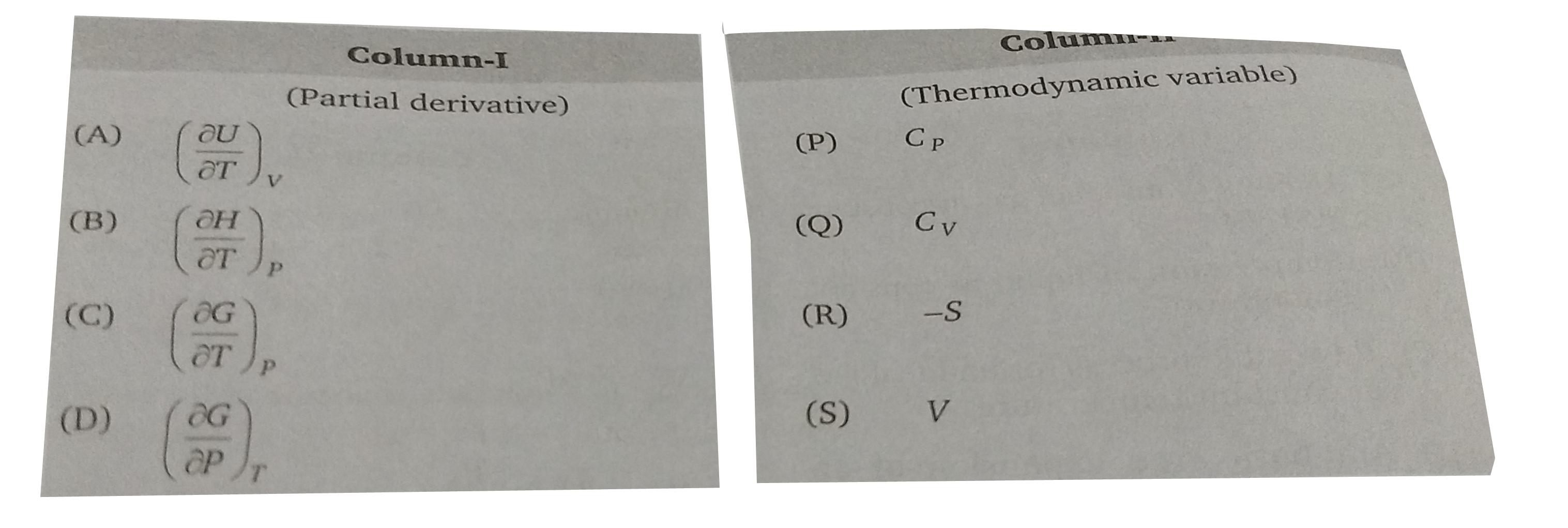Suppose that a reaction has ΔH=−40kJ and ΔS=−50J/K. At what temperature range will it change from spontaneous to non-spontaneous? Solution in Punjabi
0.8 K to 1 K
799 K to 800 K
800 K to 801 K
799 K to 801 K
The correct Answer is:D
ΔG799=−40×1000−799×(−50),
ΔG799=−50 J spontaneous
ΔG801=−40×1000−801(−50)
ΔG801=+50 J non-spontaneous
Topper's Solved these Questions
- THERMODYNAMICSBOOK - NARENDRA AWASTHICHAPTER - THERMODYNAMICSEXERCISE - Level 3 - One Or More Answers Are Correct
1 Videos
- THERMODYNAMICSBOOK - NARENDRA AWASTHICHAPTER - THERMODYNAMICSEXERCISE - Level 3 - Match The Column
2 Videos
- THERMODYNAMICSBOOK - NARENDRA AWASTHICHAPTER - THERMODYNAMICSEXERCISE - Level 2 (Q.1 To Q.30)
1 Videos
- STOICHIOMETRYBOOK - NARENDRA AWASTHICHAPTER - STOICHIOMETRYEXERCISE - Level 3 - Subjective Problems
20 Videos
Similar Questions
Assume ideal gas behaviour for all the gases considered and neglect vibrational degrees of freedom. Separate equimolar sample. Separate equimolar samples of Ne, O2 , CO2 and SO2 were subjected to a two process as mentioned. Initially all are at same state of temperature and pressue.
Step I → All undergo reversible adiabatic expansion to attain same final volume, which is double the original volume thereby causing the decreases in their temperature.
Step → After step I all are given appropriate amount of heat isochorically to restore the original temperature.
Mark the correct option(s) :
View SolutionMatch the following columns

View SolutionWrite structure of 2,2-dimethylheptane.
View SolutionWhat volume of a liquid (in L) will contain 10 mole ? If molar mass of liquid is 280 and its density is 1.4 g/mL.
View SolutionWhat are the signs of DeltaH^(@) and DeltaS^(@) for a reaction that is spontaneous at all temperature?
View SolutionWhat are the sign of ΔHandΔS for a reaction that is spontaneous only at low temperatures?
View SolutionSuppose that a reaction has DeltaH=-40kJ and DeltaS =- 50J//K . At what temperature range will it change from spontaneous to non-spontaneous?
View SolutionMatch the column :-
Sign ofΔH&ΔrespectivelyNature of reaction−&−PSpontaneous only at low temperture−&+QSpontaneous only at high temperature+&+RSpontaneousatalltemperature+&−Snon spontaneous at all temperature
View SolutionDetermine whether the reactions with the following ΔHandΔS values are spontaneous or non-spontaneous. State whether the reactions are exothermin or endothermic.
(a) Δ=−110kJ,ΔS=+40JK−1 at 400K
(b) ΔH=+40kJ,ΔS=−120JK−1 at 250K
View SolutionFor a certain reaction, ΔH=−50kJandΔS=−80JK−1, at what temperature does the reaction turn from spontaneous to non-spontaneous ?
View SolutionFor a certain reaction Delta H^(@) =- 224 kJ and Delta S^(@) =- 153 JK At what temperature will it change from spontaneous to non- spontaneous ?
View SolutionAssertion : If both DeltaH^(@) and DeltaS^(@) are positive then reaction will be spontaneous at high temperature. Reason : All processes with positive entropy chang are spontaneous.
View SolutionA reaction is spontaneous at a temperature of 300K, but it is non-spontaneous at a temperature of 400K. If DeltaH and DeltaS for the reaction do not depend on temperature, then-
View SolutionUnder what condition of DeltaG, DeltaH or DeltaS , a reaction will be spontaneous at all temperature?
View SolutionWhat are spontaneous and non-spontaneous process? Under what conditions will the reaction occur if:
(i) both ΔH and ΔS are positive
(ii) both ΔH and ΔS are negative?
View SolutionA reaction is spontaneous at 300K temperature but spontaneous at 400K temperature. In the reaction DeltaH Oh DeltaS - When the value of temperature is neutral in the reaction:
View Solution
